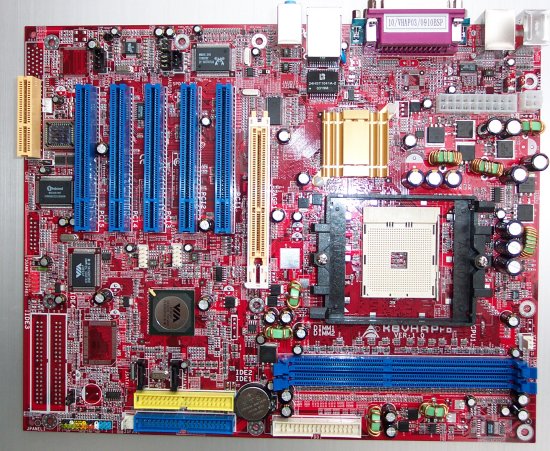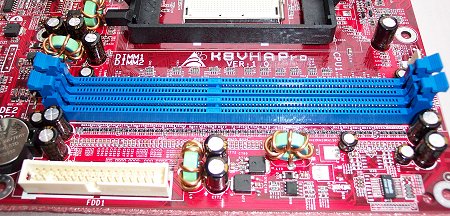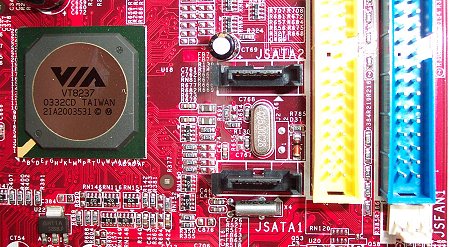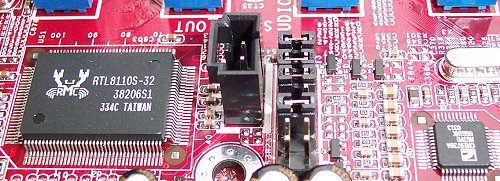K8VHA Pro layout and features
There's little need for us to discuss the merits of the chipsets in detail. We've done that once before. If you'd like to refresh your mind as to how and why the Athlon 64 3200+ is reckoned to be so good, together with a formal look at VIA and NVIDIA's chipset support for the 754-pin Clawhammer, head here. VIA and NVIDIA went about design in differing approaches. The end results, however, were largely similar.We'll take a look at the Biostar K8VHA Pro first. It's powered by VIA's K8T800, which still uses two discrete bridges for translation and routing work.

Biostar proudly announces that the K8VHA Pro is on AMD's current recommended list. We suppose that in the initial few months after a new CPU's inception, it's important to have the manufacturer's support. VIA, as you can see, still maintains separate North and South Bridges for its K8T800 series. The board measures a regular 305mm x 244mm yet feels pretty busy. Components are strewn everywhere, and the CPU's retention bracket seems to have been moved down the board a little.

The K8T800 North Bridge sits right next door to the CPU, and it can be used for the Opteron / FX-series of CPUS (940-pin) with their 128-bit dual-channel memory controllers or, as here, for the Clawhammer with its single 64-bit memory controller. In both cases, AMD decided to incorporate the said controller right on the CPU, for super-fast access. The NB's primary job, therefore, is to mete out data to the graphics card via the now industry-standard 8x AGP interface (up to 2.1GB/s). As VIA likes to extoll, the link between the CPU and NB runs at full speed, which is 1.6GHz/s with a 16-bit bus. Biostar decides to group the power connectors at the edge of the PCB. We like this position as it doesn't interfere with the CPU cooler's airflow.

The Athlon 64 3xxx+ CPUs will be targeted at the enthusiast and gamers probably more so than the workstation market. That'll be the domain for the FX-5x and Opteron duo, who in 1P mode are essentially the same chips. Biostar chooses to use only 2 DIMM slots that afford the average user a maximum of 1GB of RAM. It's single-channel, so DIMMs don't need to be necessarily matched. Biostar also chooses to include only the floppy port connector on the RAM side of the board.

Part of the VT8237's attractiveness as a modern South Bridge is with its on-chip SATA support. It can run in RAID0 and RAID1 formats immediately, and it has the ability to service another couple of SATA drives via an external physical layer. Biostar decides two is enough on this occasion. The PATA ports and second fan header have been moved down next to it. VIA's own VT6307 provides 2-port FireWire support. It's a single-chip solution, that is, it does the entire work by itself.

Moving on around provides the user with a couple of goodies. Firstly, Realtek, who seems to be everywhere on current motherboards, provides the Gigabit, PCI-based, LAN On Motherboard (LOM). Gigabit Ethernet is much like Wireless standards. It never reaches its maximum throughput ability but it sounds oh-so-good on paper. The CMI's 9739A sound CODEC is used to provide reasonable on-board sound from the VIA VT8237. Biostar could have used a number of VIA's sound chips but went with the passable 6-channel support from CMI. There's a header for S/PDIF transfers which, thankfully, is used on the K8VHA Pro.
We're not great fans of the PCI slots arrangement. The first slot is too close to the AGP port. We doubt that users would want to sacrifice precious GPU fan airflow by using the first slot. Then there's the question of the CNR slot. It's probably included as Biostar intends to offload these boards to system integrators. We'd prefer it if Biostar moved the PCI slots down a rung and relocated the Winbond monitoring chip. Biostar also seems keen to produce a number of different models from one base chipset. Here we see that IDE RAID is an optional extra.

The ubiquitous 4x USB2.0 and FireWire ports are present. Biostar keeps legacy firmly in mind with a couple of serial and a single Parallel port available. The features are certainly there, but we'd probably look towards a little component and port relocation.









